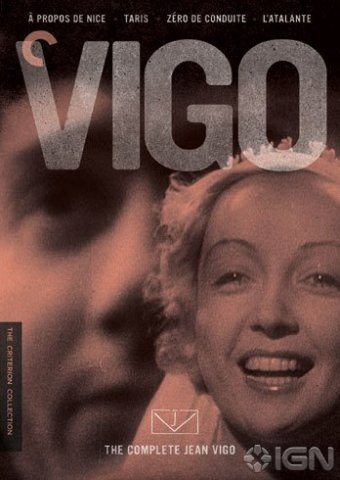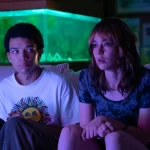Home Video Hovel: The Complete Jean Vigo
One of the true highlights of my four years at Emerson College was taking a class titled, in the grand academic tradition of using many more words to say very little, “European Cinema: Sight and Sound.” I took the class because, the summer prior, I had really started to wade into the classics of foreign cinema (your Bergman, Godard, Antonioni, etc.), so while I already had my bona fides in the topic, I was delighted to discover how much I still had to learn. It was there that I first learned about, or experienced firsthand, Marcel Carne, Jean Cocteau, Roberto Rossellini, and many others.
Prime among them was Jean Vigo. Before we even saw a frame of his work, our professor told us the tale of this cinematic prodigy who came out of nowhere to create a couple of wonderful short films. He knew he was dying of tuberculosis, which he’d contracted in his early 20s, but only worked all the harder to complete one feature film before the disease overpowered him. He was able to complete it months before dying at age 29. Then we watched that film – L’Atalante.
It’s easy to fall into hyperbole when discussing L’Atalante, which is a rather slight, modest effort, but masterfully so. The story, such as it is, is of a couple of newlyweds – she’s never left the village in which she was born, he’s the captain of a small cargo boat – trying to figure out their life together aboard his boat, “L’Atalante.” In the commentary track, Michael Temple admits that the magic of L’Atalante cannot be described, and the best I can offer is that it seems absolutely effortless. That’s no small achievement when you consider that the film was shot mostly on location during a very harsh winter while its director was dying. The film seems to walk on air, drifting along the river, through the various ports and towns. At times it seems to dance with the surreal, as when Jean and Juliette walk directly from their wedding (still in a tuxedo and gown, respectively) onto the boat, but it hardly goes as far as Cocteau or Bunuel. If Vigo is to be classified, “poetic realism” would not be an unfit designation, but not in the manner it’s usually applied.
The classic works on poetic realism – typified by Jean Renoir (The Rules of the Game, Grand Illusion) and Marcel Carne (Port of Shadows, Children of Paradise) – were those that used language eloquently to explore the nuances of emotion within realistic settings. As regards the latter, Vigo is not only in total compliance, but certainly does the stagebound Carne one better by shooting on location. One of his goals in making the film was to explore life on a barge, not from any sociopolitical perspective, but a simple fascination with that way of work, that slice of life. But Vigo’s language – he co-wrote the screenplay with Albert Riera, working from a story by Jean Guinee – is much more limited. His poetry comes from his camerawork, which is often fixed but through the use of the boat seems to glide, and his editing, which grows increasingly diffuse and elliptical as the picture goes on (though we learn in the supplements this was as much for practical reasons as artistic ones, we judge a film by its result, regardless of its process).
The package put together by The Criterion Collection would absolutely be worth it had they only given us L’Atalante, but it ain’t called The Complete Jean Vigo for nothing. You get two of his short films – “Apropos de Nice” and “Taris” – as well as his 44-minute film Zero de Conduite, the tale of revolution in a French boarding school. “Apropos de Nice” is a 23-minute classic silent “city movie” (not unlike People on Sunday or Man with a Movie Camera), showing an idyllic summer day from several socioeconomic perspectives (and no small amount of visual commentary by Vigo and his co-director/cinematographer Boris Kaufman). It’s an absolute joy if you’re up for that sort of thing, presenting unceasing visual wit and a certain willingness to try anything. It provides a good bedrock to build upon when getting into Vigo, because he’ll continue to use documentary practices of being open to anything and everything, and exploring “real” aspects of life, without ever really turning his films into journalism. It features a tremendous score by Marc Perrone.
“Taris” was a commissioned piece, a short film giving basic swimming instructions with swimming champion Jean Taris, which gets pretty fun and surreal in the last two minutes of its scant nine.
Zero de Conduite really cemented Vigo’s reputation, and rightfully so. It’s a little uneven, stretching to fill its short running time without ever quite relaxing, but it’s remarkable in certain formal aspects (use of slow-motion, a quick bit of animation sharing the screen with live-action) and joyously anarchic. Vigo’s father was a militant anarchist, and that influence is felt most prominently here. In his commentary track, Temple explains that true anarchy shouldn’t be a negative impulse, but a positive one, and Vigo clearly feels that here as well.
In terms of audio/visual quality, the key words here are “grading on a curve.” It should go without saying that films made between 1930 and 1934 aren’t going to look as good as Inception, even on Blu-Ray, but even in a fair match-up, these don’t quite hold water. The transfers present neither the shimmering perfection of the Masters of Cinema City Girl disc, nor the rough-around-the-edges-but-still-breathtaking Buster Keaton films from Kino or Criterion’s own Stagecoach. And unfortunately, L’Atalante suffers most, giving some of the most splendid high-definition images I’ve seen one second, and looking like it was just pulled from a storage closet the next. At first I wondered if Criterion had simply maxed out the space of the disc (nearly three hours of film plus another three of extras plus commentaries), and were compressing these films needlessly, but this is where we get to “grading on a curve.”
L’Atalante did not enjoy a happy life until long after its initial release. The studio, Gaumont, trimmed the film down to 65 minutes upon release, and it wasn’t until the 1990s when a satisfying full cut (89 minutes) was found and reconstructed. As with any film that sees its elements come and go over many decades, the surviving pieces aren’t always stored with the utmost care (the most famous story is the print of The Passion of Joan of Arc that was found in the closet of a mental institution), and often incur irreparable damage. When those conditions are put upon a film that was shot on location in an age when very few films were (and on a small budget), it’s not terribly surprising that L’Atalante could come out looking less than perfect. But I watched the film through three times (including once with the commentary track), and felt that the level of detail in the print – that is to say, damage marks, grain, etc. – was so finely transferred that Criterion is just giving us the best of what they had to work with. And again, some shots are so close to perfect that if it was simply a matter of over-compression, surely the film would have suffered more uniformly. Whether the print itself could have been further cleaned up is beyond my knowledge, both because I haven’t seen the print firsthand and know only a little about that physical process.
Nevertheless, what we do get is very good, and is a remarkable transfer of an actual, honest film print. Depth is quite nice, and the level of detail is often quite good. It’s one of the closer representations of an actual print I’ve seen on home video, and if you were to see this projected, you’d simply look past the damage and delight in the film.
The other films fare similarly, with “A Propos de Nice” looking best of the bunch most consistently. “Taris” shows the most consistent damage, but the image underneath is still spectacular. Zero de Conduite looks pretty great, making the most effective use of those endless blacks high-def technology can produce.
For the three films requiring audio attention (Perrone’s score for “A Propos de Nice,” recorded in 2001, naturally sounds quite good), I must say they’re what you’d expect. Suitable – mono audio all the way – but not exceptional. They crackle, but never warble. Levels are consistent. The music, always so wonderful in each film (I could have written a paragraph on L’Atalante’s score alone, but this isn’t the place), comes through clearly enough to be appreciated, but wounded enough to have come from another era. Certainly fitting.
The supplements are considerable, starting with commentaries on all four films by Michael Temple. Temple literally wrote the book on Vigo (simply titled Jean Vigo, it sadly seems to be priced for the academic market), and does pretty decent commentaries. His insights won’t convert anyone, but if you’re already a fan looking to learn more, each one is vital. I took a ton of notes thinking I’d have space for them in this review, but I learned a lot listening to Temple speak, and found his insights into the notion of documentary practices in fictional, expressive filmmaking especially valuable.
There’s an alternate edit of Apropos de Nice, which isn’t quite accurate – we don’t get a whole other complete cut, but rather the segments are cut a little differently, with some footage added and other bits removed. Not strictly necessary, but again, they really earn the “Complete” part of the set’s title.
Cineastes de notre temps (“Filmmakers of Our Time”) is a television program in France presenting documentaries on important artists or movements, so here we’re treated to a massive 98-minute program on Vigo from 1964. They interview many of his collaborators, focusing mostly on Zero de Conduite and L’Atalante, and it’s an absolute joy to take in. This, more than any of the extras, could convert a nonbeliever. I only wish they’d provided captions for each participant, as, especially keeping up via subtitles, it was difficult to keep all the subjects straight.
Eric Rohmer interviews Francois Truffaut about Vigo’s work, primarily L’Atalante and its effect on his own work as well as cinema at large, for about 20 minutes. Truffaut, among his many other attributes, is a tremendous lover of cinema, and is very articulate and passionate in these sorts of things. Ironically, Truffaut famously said, “I demand that a film express either the joy of making cinema or the agony of making cinema,” while Vigo’s work falls defiantly outside of that category, making what was clearly an extremely difficult process look absolutely effortless. But then again, by all accounts Vigo loved every second, so maybe this Truffaut fella is onto something.
Les voyages de ‘L’Atalante’ is for hardcore Vigo fans only. It purports to trace the many variations of L’Atalante on its journey from curious enterprise to failure to rediscovered treasure to cinematic classic, but it does so almost entirely by showing variations on scenes, and how the film itself has evolved over its many incarnations. Again, I found it fascinating (there are even some bits of rushes showing Vigo directing!), but if you’re not already a big fan of L’Atalante and Vigo, it’d be a massive bore.
Criterion also provides an interview with director Otar Iosseliani (of whose work I am totally unfamiliar), talking about his appreciation for Vigo and how it’s influenced him. It’s fine, but it’s nothing we haven’t heard many times over if, like me, you’re watching this last.
Finally, there’s the delightful 45-second animated tribute by Michel Gondry.
And of course it wouldn’t be a Criterion package without a tremendous booklet. I don’t typically read their booklets right away, but it’s always immensely rewarding to dive into them, and this one – with essays by Luc Sante, Robert Polito (who wins the award for Most Diverse Criterion Contributor in a Single Month, as he contributed his insight into Jim Thompson’s work on The Killing for Criterion’s disc), Michael Almereyda, and filmmaker B. Kite – is about as good as they come. Beautifully designed, dense but not overwhelming (40 pages is a lot, but Criterion’s certainly given us more to wrestle with), and full of great insights and fantastic writing.
Much as it’s tempting to say “you don’t love cinema unless you own this,” I begrudgingly admit that there may be those out there who don’t cotton to Vigo’s work, and this set doesn’t open up the cinema itself in an essential way that requires ownership regardless of one’s taste (and if you don’t think that’s possible, go through the extras on Criterion’s release of L’Avventura). If you’re not familiar with Vigo’s work, I really, strongly urge you to at least rent this and watch all the films (163 minutes total! It won’t even take three hours!), and you can certainly blind buy with a fair degree of assurance. I know I’ve never regretted buying a piece of cinema that has withstood the test of time as strongly as these have (which have had many opportunities to be removed from the conversation). If you already love Vigo’s work, there is unlikely to be a more important home video release this year, and it is already a disc I am so overjoyed to own.






























